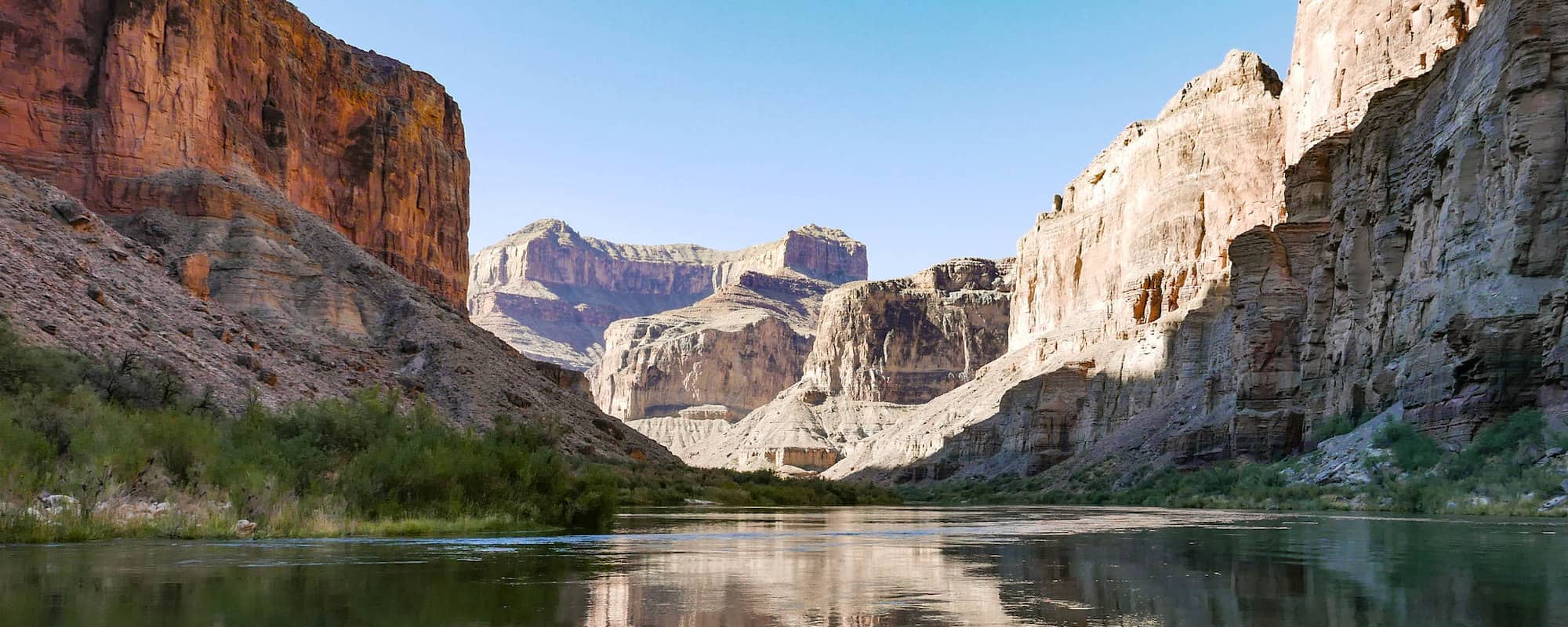by Cora Reese
Driving up to the Groundwork farm in Paonia, I had no idea what I was getting into. Our van sputtered down the Colorado roads, past tall coniferous trees growing in pinkish-orange soil, surely sending rocks skittering as we descended into a stunning valley of yellow aspen and wide green farmland. The van rocked with music (usually Caamp or Taylor Swift) and shook with our dancing – at this point in our semester, the invigorating rattle is embedded in my mind.
Eventually, we rode down a quiet street dotted with little houses peeking out from the shady trees and green and reddish-brown fields. We parked next to an unassuming gray-blue building. Once we hauled our bags inside, however, we were amazed. The shiny wood floors of this dance studio were immediately tarnished by our dirty sock prints as we spun and leaped around in front of a wall-to-wall mirror. Chloe found an old piano and put her classical training to use as we set up everything. If you had walked in right then, you would’ve seen ten girls silhouetted by the light from the huge windows dancing, lounging on the couches, staring out at the garden and cow pasture, or mesmerized by the tea that our kind host Jeff set out for us.
As the afternoon progressed, we met Madeleine’s friend Jeff and took a quick tour of our new home for the next three days, including into their co-op store where buckets of produce, spices, honey, and so much more were organized around tables and racks. It smelled so good in there – like farm dust and delicious food. We were lucky enough to be able to eat some of this delicious food throughout the next few days. We picked apples and pears right off the trees. But that day, after our dinner ritual and setting up tents for people with colds, we hit the hay (get it) and went to sleep.
In the morning, awoken in part by the Paonia coal train hurtling past, we got to work. Nell, our Leadlet for the day, prepared us for the day with a remnant of our Missouri River canoeing: cheesy breakfast bagels. That morning, Jeff arrived with a truck bed filled with bags and boxes filled with grasses, various plants, and an array of seed processing tools. We hauled the boxes heavy with filters and tupperware inside the dim room and sat down for a seed talk. We each started with two ears of corn – but not just any corn. The Paonia farm does plenty of work making their agriculture as eco-friendly as possible, but they also grow many endangered seeds. Industrial agriculture has sparked an overshadowing of traditional plant varieties with nutrient-hungry and water-thirsty, massively productive hybrid varieties. That Sunday, two rare corn cobs lay in our laps as we learned about local food, seed diversity, food sovereignty, economics, the Green Revolution, and the intergenerational safeguarding of plant varieties in many cultures and communities. Jeff cut up two rare Siberian watermelons and we filtered out probably over two hundred dark seeds, spitting them into a green bowl in the half hour we sat there intently listening to his stories. He told us that was the best way to process watermelon seeds, but personally I was just excited we could eat as much watermelon as we wanted.
Jeff spilled a pile of wheat-like grass at the foot of the couch we were perched on and we began the seed processing… process? Basically, it consisted of stomping, filtering, and winnowing. We started by parading and dancing all over the grass and various other plants he set out, hearing the satisfying crunch of the seeds coming loose on the wood floor that was quickly coagulating dust. Pretty soon, we had a ton of hay we set aside for the chickens and a big pile of little sticks, seeds, and seed casings that had already come apart. Next was to filter it all! Over a wide metal bowl, we poured tupperwares of our seed-stick mixture into a wood-framed grate, then from the bowl into the tupperware, and back and forth and back and forth over increasingly fine grates until all we had was dirt, seed casings that were impossible to pick up with just our fingers, and little seeds the size of grains of rice. It was surprisingly satisfying, but not as satisfying as what we were about to do. Jeff gave us an excellent demonstration and we split up into pairs to begin winnowing (not wallowing, that’s what bison do).
Tess and I took to the concrete porch, accompanied by the farm cat Mustachio watching carefully from afar, and began to blow out all the dust and seed casings we couldn’t filter, dropping them from one bucket to another and eradicating the lighter grass bits in the breeze. It took a fair amount of practice – we both choked on seeds casings a couple times – but soon enough we had it down and we ended with yellow seed casings covering us both. They decorated my jeans, filled my sweatshirt hood (I’m not sure how they ended up behind me?) and they clung to me like the dirt from that one character in the Peanuts. I even found them in my sleeping bag that night. But even after we swept out our mess from the dance studio, the day was just barely halfway done. We were going to do something the vegetarian crew (myself, Ella, and Maylie) had been dreading just about the whole day – process a chicken.
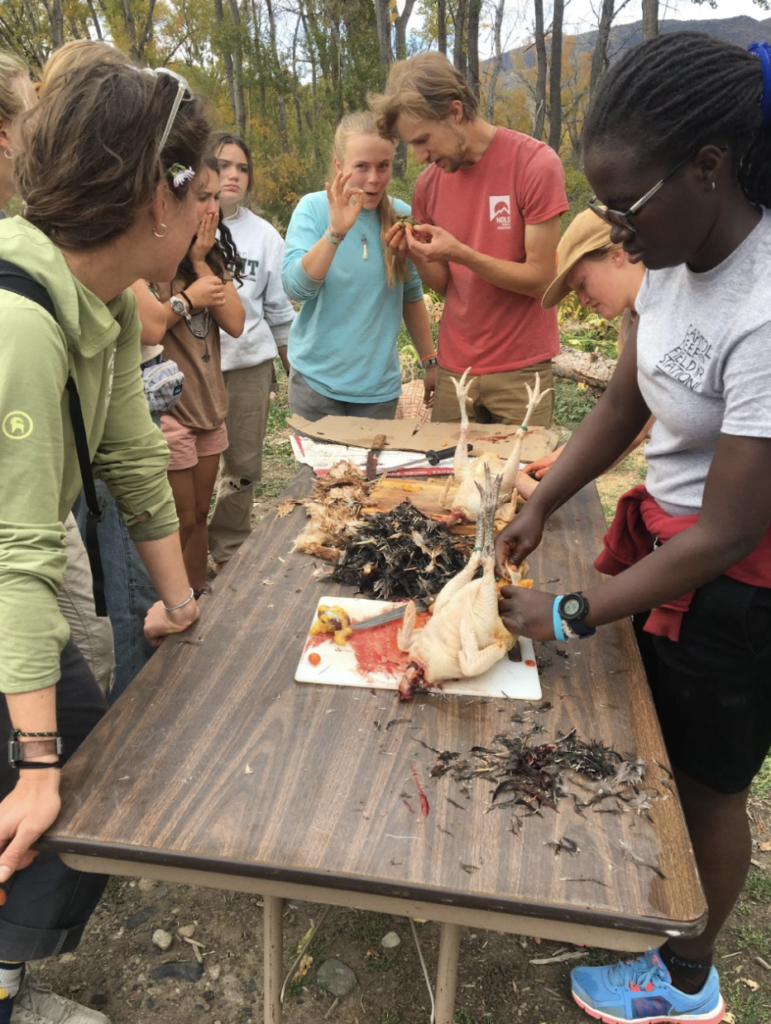
Nell and Jeff did an excellent job of quelling most of my nerves but I still felt a little sick as we walked past the cow pasture, the apple trees lining the drive, the pear orchard that dropped delicious fruit with just a shake. The entire farm is so peaceful and calm, a serene landscape that sleeps in the shadows of the mountains surrounding the valley. It reminds me a lot of my cousin’s farm in Corvallis, Oregon, but with a whole lot more aspen trees. Both places have a warm homey feel no matter if you’re in the garden, by the river, or sitting on the co-op stairs watching the cows. Maylie and I spent a good amount of time reminding ourselves of this homey feeling as we pet chickens while the meat-eaters set up folding tables. Eventually, Jeff picked out two old hens that had lived long, happy, and peckish lives rooting for bugs and eating rocks under the blanket of shrubbery in the huge coop. I’ll skip the more gory bits because it still makes me a bit squeamish, but the chickens were decapitated quickly and Biz led a quick biology lesson of the brightly colored insides as Nell and Chloe cleaned out the birds.
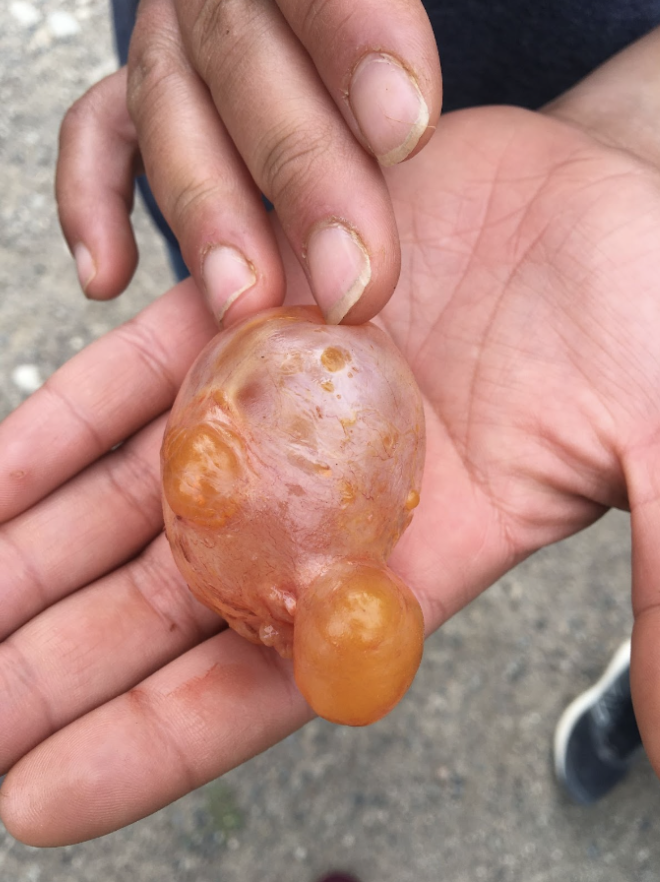
What was particularly interesting about that was that we discovered partly formed eggs inside the chickens! In fact, Madeleine kept an unusually lumpy one with the intent of preserving it in salt!
Currently, Elmer, as she named it, lives in the passenger seat cup holder of the van and rocks out with us to our music. I’m not sure at what point in the semester Elmer is completely preserved but while the chicken team diligently cleaned up, Madeleine and Elmer accompanied Maylie and I on a pear picking excursion. We proudly brought back our pears in a big ol’ basket to our home where they disapPEARed quickly (hahahaha). That evening, the camp stove wafted spiced chicken (and tofu) with a side of fresh fruit up onto the clear constellations as we mustered for dinner. Dinner was also prefaced by Malia’s crew, the Chicks, exploding into a chicken dance to their remix of Fine by Me by Andy Grammer! I really don’t think this blog would be complete without the lyrics but I can’t remember them. Someone might have a video. I really really hope someone has a video.
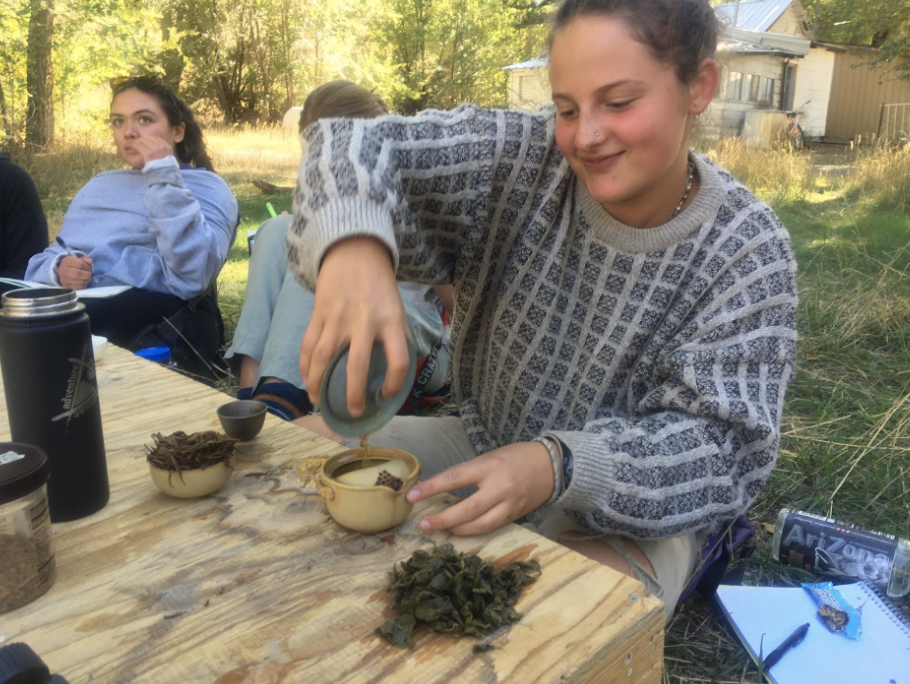
The next morning, we shot right into a half day of classes. We had Lit where we discussed the Round House, a story about a boy on the Ojibwe reservation in North Dakota growing up in the midst of his mother being attacked. Then, in Global Studies, we talked about facets of discrimination and aspects of diversity. We ate pears and the leftover watermelon the whole time, or at least I did.
After lunch, we launched into something I’d been excited for all day – a tea party! Jeff and Madeleine worked diligently at a plywood table in the middle of a grassy field to keep our tiny teacups filled with three different types of tea. We watched a video about tea plants and tea making and watched videos on Madeleine’s phone of her tea-related experiences in China. Jeff and Madeleine had been to southwestern China together as teachers so we talked a lot about how cultures around food and tea are different around the world. Tea is super social – though I’ve never experienced it that way until now – and extremely widespread. Wars have been fought and spies sent in over this little plant and its secrets. And all tea is from the same plant!
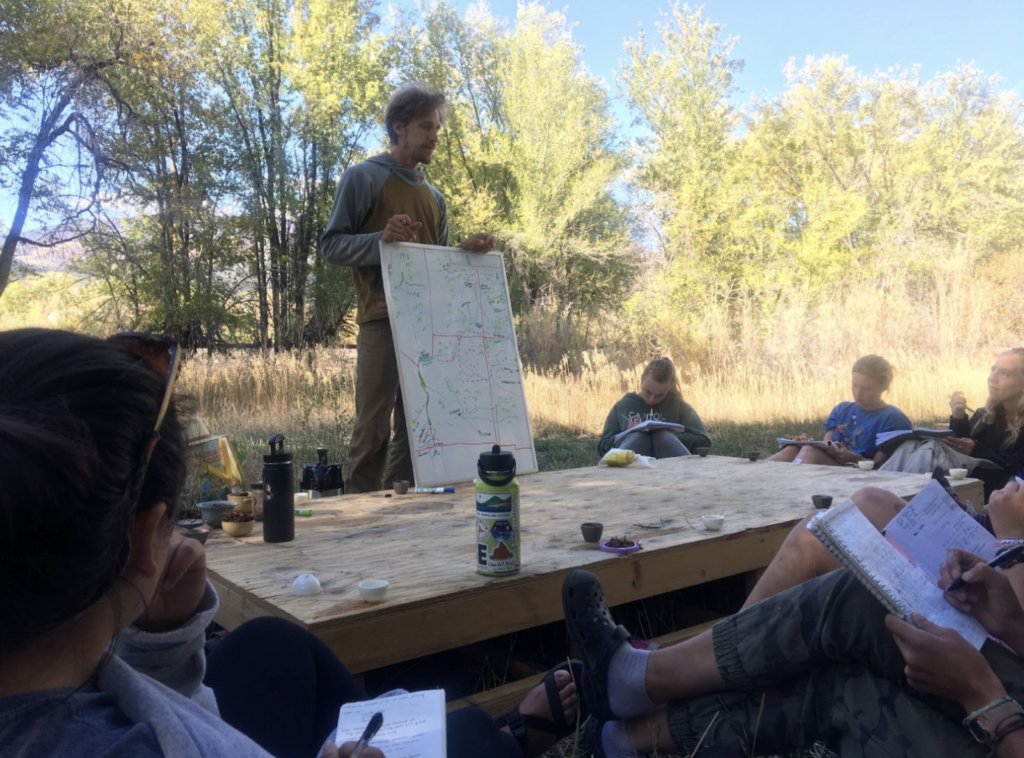
With our cups full, Jeff set out a whiteboard and told us all about water! The theme of this talk was local food systems. The Colorado river runs right through the middle of the desert and it’s supposed to go to the Gulf of California, but… it doesn’t anymore. Between the poopy laws around water rights, the useless and unnecessary dams that generate a little hydropower in exchange for a whole bunch of evaporation, and human interference in river flow to make it more suitable for farming, the Colorado River never reaches the ocean. People have known that we’ve been taking too much water since well before the construction of Colorado’s Grand Junction dam, but the solutions are often inhibited by a lack of wanting to change from beneficiaries that rely on Colorado river water like cities and agricultural sites in the Imperial Valley. About 85% of the river’s water goes to industrial agriculture. If nothing changes, places like Arizona – where I’m writing this from – might not get any water because they have the youngest water rights. So what are the solutions? Some include water conservation and habitat restoration, changing the laws, changing the crops, and draining Lake Powell and other evaporation stations. Some are just to find more water. Some people are thinking of taking Lake Michigan water and bringing it here to irrigate things. Hm. Overall, the talk was super interesting! I learned a lot for sure, took so many notes, and enjoyed my Colorado river-sourced tea.
From there, we headed over to the garden and got harvesting! We split into pairs or groups of three and harvested a whole bunch more plants that had gone to seed: beans, millet, peas, and more. Trying to collect all the millet from my plot was difficult because the stalks were so high and also raccoons (I think) had trampled through here and pressed it all into the ground where it lay in a defeated heap. The plants had persisted in that they were still alive and holding tight to the bundles of millet at the end of the stalk. Trish, Malia, and I worked in a team alongside Wyethe and Ella to fill up a big brown paper Trader Joe’s bag halfway with our picking. Unfortunately, we only got about half an hour to harvest, so pretty soon Jeff walked us back, bags loaded in our arms, to the dance studio for mentor checks and some free time. I spent it reading The Round House and taking a walk with Becky. Dinner was burritos! Bust.
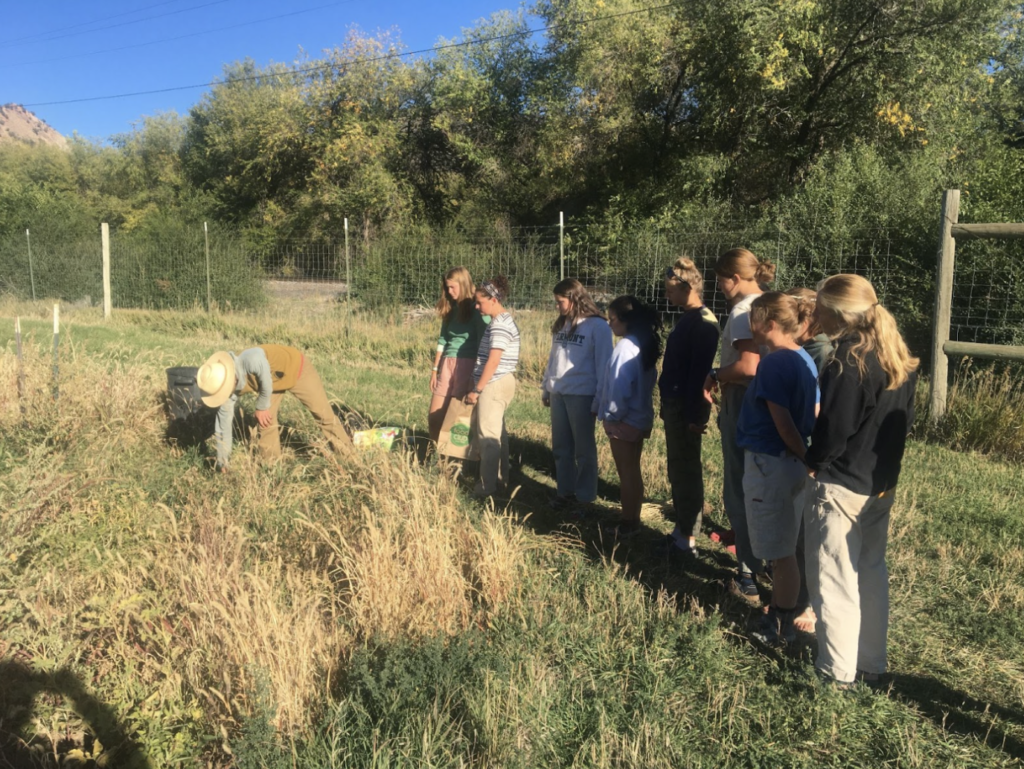
At 6:40 the following morning, Wyethe, Malia, and I ran out quietly and started a beautiful morning run down the road, back the way we came. The crisp morning air made my nose run as we jogged across the tracks and into the wide Paonia streets a mile or so. We made quiet conversation about the stars disappearing over the horizon and how night running is so nice, but pretty soon we were blasted fully awake by the coal train hurtling towards the mine.
On our return, I was gasping for air but the sun was peeking over the horizon and I ran right past the studio’s front door to start on cook crew. I woke up Maylie in her tent (I learned later they befriended Mustachio in the night!), and put out an array of sugar cereal as everyone else woke up. I rushed everyone through breakfast because our day was so packed – Becky and I spent part of our mentor check the day before trying to figure out how the heck I was supposed to schedule everything in. Mostly I complained about how days should be longer than 24 hours or we should not do anything all day. I ended with a lot of Expo marker marks on my hands and a poorly put together whiteboard schedule I’d make a lot more colorful and neat during study hall.
We packed everything up – all our bags, our boxes of food, and a bag of snacks (farm fruits!) – into the vans, but we didn’t load ourselves in right away. That’s because Stella had made an amazing discovery the previous day: EIGHT POLES! They were slightly tilted since they were on a swing set, and also they were right by the cow pasture, so cow patties both fresh and aged were scattered in the grass at our feet, but they were perfect. Stella absolutely killed teaching the pole dancing class, our P.E. for the day. Under the watchful eye of the cows, she talked about the stigmatization that comes with pole dancing and showed us the routine that we were going to learn. It looked complicated and hard but once we tried it, and learned step by step, I realized it was extremely hard and pole dancing was not what I expected at all. I knew it was going to be difficult, but not that difficult. I spun around the pole and struggled to keep my grip. Stella encouraged Emma and I to lick our palms before we tried to jump and swing around, which helped a lot and was really funny. The whole lesson was so fun and while I didn’t really get it, some people absolutely nailed it (Tess). And the whole time, the cows watched us suspiciously and curiously, right by the fence. It was really strange doing P.E. ten feet away from a massive cow, but that’s what TTS is all about, right? Unexpected experiences.
Anyway, pole dancing was a wonderful way to wrap up our farm visit. We spent a moment standing on the train tracks overlooking the greenhouse, the orchard, the field with the swingset, the co-op building, the garden, the cow pasture, the looming red and green mountains that blanketed the horizon and everything else we had explored. Before we loaded into our van, Jeff pulled up with a whole bunch of seeds, packaged and unpackaged, as well as a pinyon pine salve that smelled really good. He had us swear that we would plant the seeds once we got home and then set us loose on blue Hopi corn, swiss chard, kale, squash, and tomato seeds as well as whole Thai chili peppers to dry. We packed our collections into these beautiful seed packets Jeff said were misprints but still looked amazing and wrapped up in a little circle on the front steps. We said goodbye to Mustachio and loaded into the van. I took one last look around and then made everyone say our sentence to make sure everyone was in, and then we drove off, back the way we came.
A few takeaways I have from the farm is that I think I’ve realized it’s so important to source through local food systems. I live in Seattle, so to think that the majority of the food that I eat comes from across the country, possibly at the expense of valuable and limited Colorado River water, via greenhouse gas emissions from the transportation, and from a location that is a complete mystery. It’s kind of strange to me, now that I think about it. Having the seeds Jeff generously gave us makes me want to connect with local farmers in my area by going to more local farmers markets, even though they’re half a city away from me, and growing more food in my garden. All the seeds we have can be saved for multiple seasons if you harvest them at the right time. Plus, having these seeds will probably help me cope with my plant shopping addiction back home. Jeff talked a lot about the pride that comes with raising your own plants, so I want to grow that feeling in myself and any farmers that I buy from, as well as be more conscious about where my food comes from on a national or global scale. Hopefully, as my newly acquired seeds sprout, I’ll keep wondering about where my footprint lands on the world, both in plant-land and beyond, whether it be from my school, my hobbies, my sports. How much am I really doing with my little switch of growing a couple squash in my backyard? At this point, I’m not sure. But I may as well try, and when they hopefully emerge from the yard I hope they yield a solid amount of satisfaction and a whole lot of seeds.
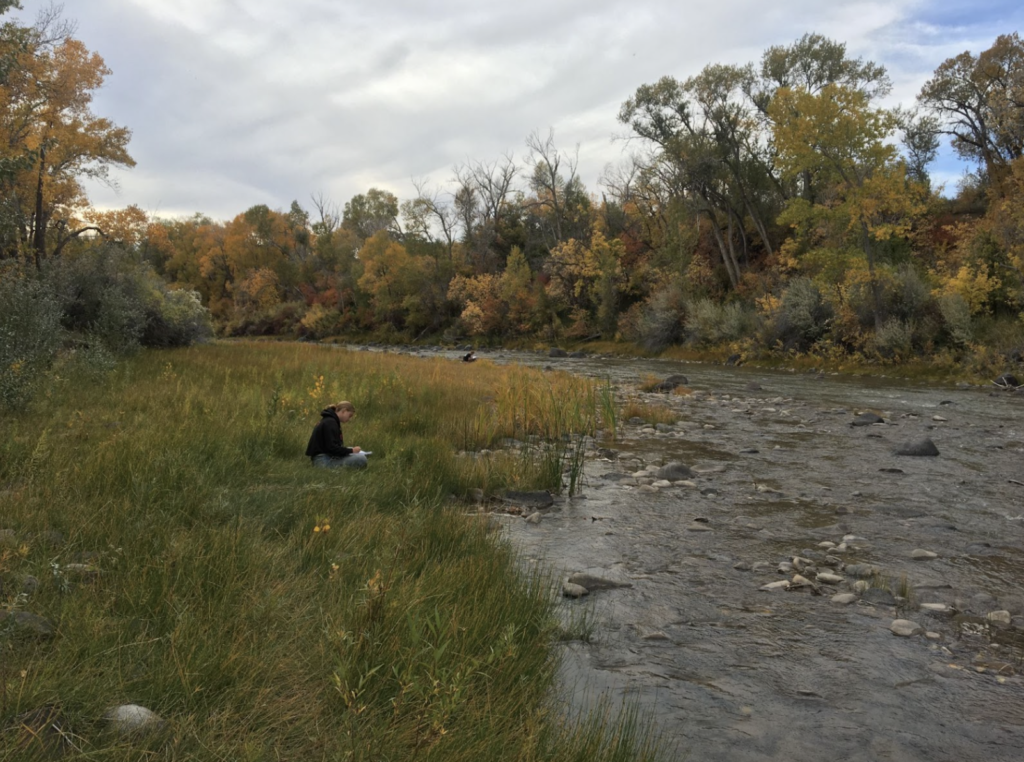
Students journaling along the North Fork Gunnison River, next to the farm.
-Cora
P.S. If you would like to sign up for Groundwork’s email list to hear more about what the farm and organization are doing, you can do so here!

